Beyond Graduation: Celebrating Distinguished Alumni Success
Every high school produces remarkable graduates—professional athletes competing at elite levels, business leaders running major corporations, medical professionals saving lives, educators shaping future generations, and entrepreneurs building successful companies. Yet many schools struggle to maintain connections with these accomplished alumni, missing opportunities to inspire current students, strengthen community pride, and build lasting engagement that benefits everyone. A distinguished alumni network and database solves this challenge by creating organized systems for identifying, recognizing, and maintaining relationships with accomplished graduates across all career fields and achievement types.
While universities have long maintained sophisticated alumni networks showcasing notable graduates, high schools are increasingly recognizing the tremendous value of systematically tracking and celebrating their own distinguished alumni. These programs serve multiple critical purposes: inspiring current students with tangible examples of what graduates achieve, strengthening school pride through visible demonstrations of institutional impact, facilitating mentorship connections between accomplished alumni and students exploring career paths, and creating engagement opportunities that support fundraising and community building.
This comprehensive guide explores how high schools can build effective distinguished alumni networks and databases, from identifying and researching accomplished graduates through implementing recognition systems that celebrate diverse achievement types. Whether you’re an alumni coordinator, athletic director, advancement professional, or administrator seeking to honor your school’s most successful graduates, this resource provides practical strategies for creating programs that strengthen connections and demonstrate lasting institutional value.
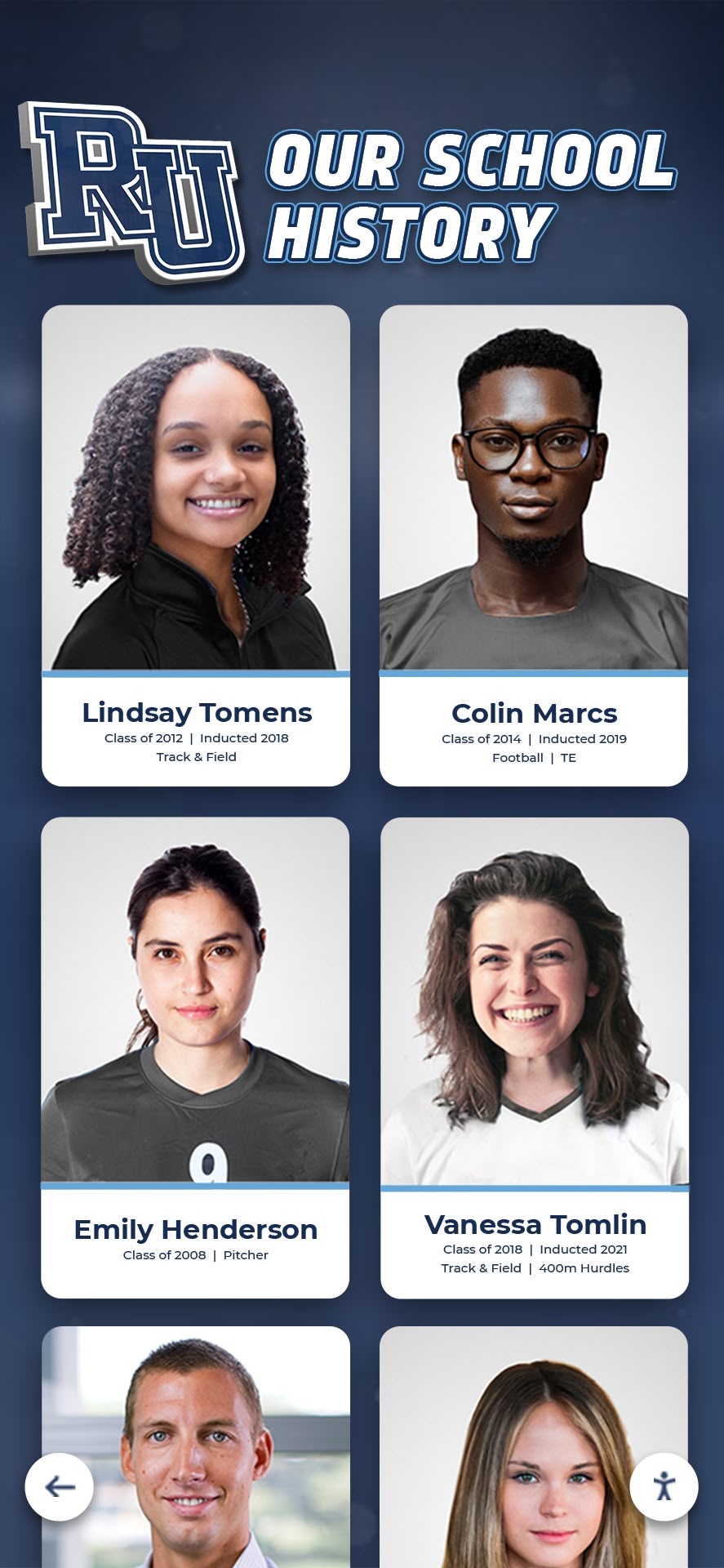
Modern digital systems showcase diverse alumni achievements through engaging visual profiles
Why Distinguished Alumni Networks Matter for High Schools
Unlike universities with dedicated advancement offices and large budgets for alumni relations, high schools typically operate with limited resources and smaller staff. This makes systematic approaches to alumni engagement even more important—schools need efficient methods for maintaining connections without overwhelming administrative capacity.
Distinguished alumni networks deliver measurable value across multiple institutional priorities that justify the investment required to build and maintain them effectively.
Inspiring Current Students Through Concrete Examples
Students frequently struggle to envision what they might achieve beyond graduation, particularly when exploring career fields outside their immediate family experience. Distinguished alumni provide tangible, relatable examples of what graduates from their school accomplish across diverse paths.
When students see former graduates who walked the same hallways, participated in similar activities, and learned from the same teachers achieving remarkable success, the examples feel accessible rather than impossibly distant. This proximity makes the inspiration powerful and actionable.
Student Impact Examples:
- Career Exploration: Students investigating possible professions can discover alumni working in fields of interest, understanding realistic career trajectories from familiar starting points
- Achievement Motivation: Visible recognition of graduate accomplishments creates aspiration and demonstrates that excellence is achievable
- Mentorship Connections: Students can reach out to accomplished alumni for informational interviews, job shadowing, or career guidance
- Academic Engagement: Knowing that notable professionals graduated from their school reinforces the value of education and effort
- Athletic Inspiration: Young athletes see graduates who competed at professional or elite collegiate levels from the same program
According to research on student motivation, exposure to “near-peer” role models—people just a few steps ahead on life’s path—proves more motivating than celebrity examples that feel unattainably distant. Distinguished alumni fill this near-peer role perfectly.
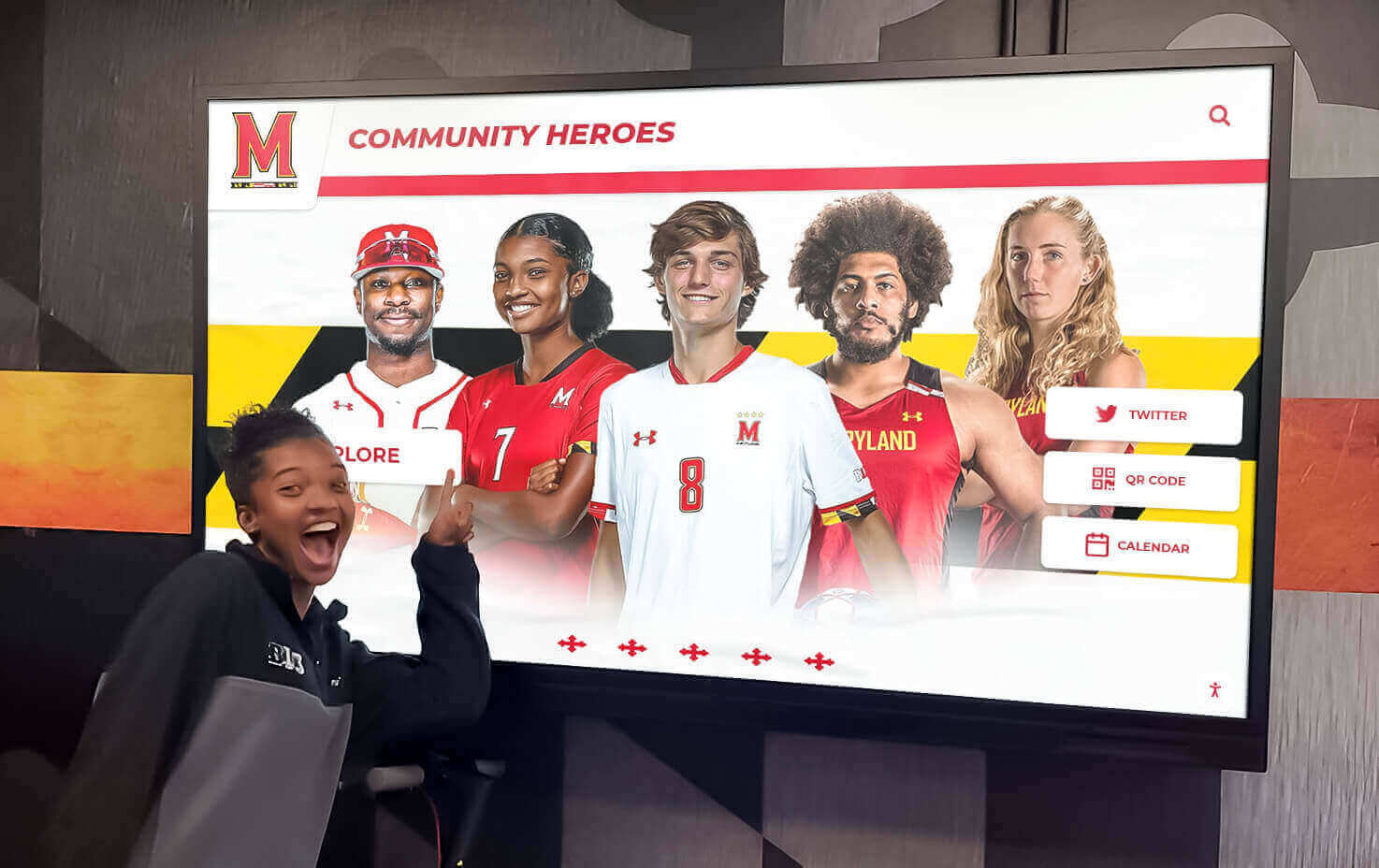
Students engage with displays showcasing successful alumni from their school
Strengthening Community Pride and School Reputation
Every accomplished alumnus represents proof of institutional quality and impact. Systematically showcasing these successes strengthens community pride while demonstrating educational value to prospective families evaluating school options.
Community Benefits:
- Institutional Reputation: Visible evidence of graduate success enhances school standing in community perceptions and competitive comparisons
- Recruitment Advantage: Prospective families see concrete outcomes when evaluating educational options for their children
- Community Connection: Local residents take pride in schools producing notable leaders, athletes, and professionals
- Property Values: Strong school reputations supported by alumni success contribute to neighborhood desirability
- Community Support: Pride in graduate achievements translates to support for school initiatives, funding campaigns, and facilities improvements
The National Federation of State High School Associations reports that schools with active alumni recognition programs demonstrate measurably higher community satisfaction scores and receive stronger support for bond initiatives and fundraising campaigns compared to schools without systematic alumni engagement.
Facilitating Valuable Mentorship and Career Connections
One of the most practical benefits distinguished alumni networks provide involves creating mentorship and career development opportunities for current students. Accomplished graduates often express willingness to give back through guidance, internship opportunities, or career advice when schools provide structured connection mechanisms.
Modern interactive alumni directories enable students to discover graduates working in fields they’re exploring, understand career paths from familiar starting points, and request informational interviews or mentorship relationships.
Career Development Applications:
- Informational Interviews: Students contact alumni to learn about specific careers, typical work experiences, and educational requirements
- Job Shadowing: Alumni invite students to observe professional environments and daily responsibilities
- Internship Opportunities: Graduates provide summer or school-year internships at their companies
- College Guidance: Alumni who attended specific universities share application advice and campus insights
- Professional Networking: Students build valuable connections in fields they plan to enter
Research from the Harvard Graduate School of Education shows that students with mentor relationships demonstrate higher college completion rates, stronger career satisfaction, and faster professional advancement compared to peers without mentorship access—making alumni mentorship programs valuable investments in student success.
Supporting Fundraising and Development Efforts
While high schools traditionally rely less on alumni giving than universities, many schools are discovering that engaged alumni represent untapped philanthropic potential for facility improvements, scholarship programs, and academic initiatives.
Distinguished alumni networks create engagement infrastructure that supports development objectives by maintaining connections, demonstrating appreciation for graduate success, and creating natural giving opportunities.
Development Applications:
- Major Gift Prospects: Successful alumni with capacity to make significant contributions appreciate recognition and connection
- Annual Giving Participation: Engaged alumni demonstrate higher giving rates than disconnected graduates
- Capital Campaign Support: Recognition opportunities (named spaces, scholarships) attract alumni donors
- Volunteer Recruitment: Distinguished alumni serve effectively on advisory boards, committees, and fundraising initiatives
- Peer-to-Peer Fundraising: Accomplished alumni recruiting their networks proves more effective than institutional solicitations
Schools implementing comprehensive alumni engagement strategies report that even modest increases in giving participation rates generate substantial funding for programs that tuition and tax revenue cannot support.
Building Your Distinguished Alumni Database: Research and Identification
Creating an effective distinguished alumni network begins with systematic research identifying graduates who have achieved notable success across diverse fields and achievement types.
Defining “Distinguished” for Your Institution
Different schools operate in different contexts with varied alumni populations. Your definition of distinguished achievement should reflect institutional values while remaining broad enough to recognize diverse success types.
Considerations for Your Definition:
Professional Achievement:
- Business leadership (CEOs, executives, entrepreneurs)
- Professional athletics (professional, Olympic, elite collegiate)
- Medical and healthcare professionals
- Legal and judicial accomplishments
- Academic and research contributions
- Arts and entertainment success
Service and Impact:
- Public service and elected officials
- Military service and leadership
- Nonprofit leadership and social entrepreneurship
- Education and teaching excellence
- Community service and volunteerism
- Humanitarian work and advocacy
The most inclusive programs recognize that distinguished achievement takes many forms—the teacher who influences thousands of students over a career demonstrates impact equal to the business executive, even if the recognition looks different externally. Avoid focusing exclusively on wealth or celebrity at the expense of service, education, and community impact.
Research Methods for Identifying Accomplished Alumni
Most schools discover they know less about graduate outcomes than they assume. Systematic research uncovers remarkable alumni stories hiding in plain sight.
Effective Research Approaches:
Existing School Records: Start with what you have—graduation records, yearbooks, athletic records, academic honors, and extracurricular participation histories provide foundation information for research
Social Media Discovery: LinkedIn proves particularly valuable for professional achievement research, while Facebook, Instagram, and Twitter reveal community involvement and personal accomplishments
News and Media Searches: Local news archives, industry publications, and professional journals frequently feature accomplished individuals; search graduate names with graduation years
Alumni Surveys: Direct outreach asking graduates about career paths, achievements, and willingness to be featured generates both information and permission
Community Referrals: Current staff, parents, and community members often know about accomplished alumni through personal or professional connections
Professional Directories: Industry associations, professional organizations, and academic directories list members with educational backgrounds
Athletics Databases: For professional and elite athletes, sports-reference websites, league rosters, and college athletic departments maintain comprehensive records
Class Reunion Participation: Reunion attendees represent engaged alumni often willing to share updates and connect you with accomplished classmates
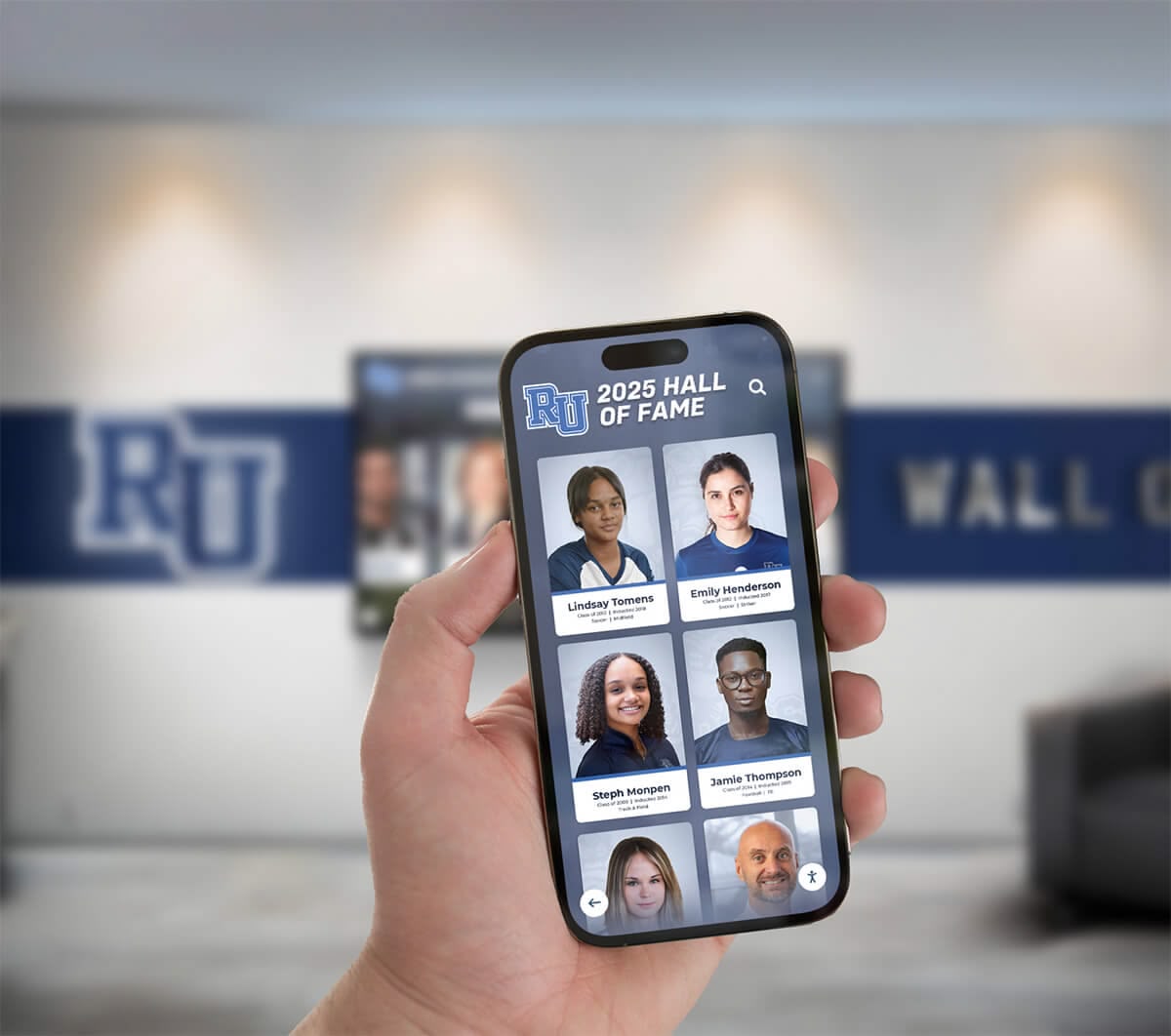
Mobile-accessible alumni databases enable easy updates and ongoing engagement
Organizing Information Systematically
As research identifies accomplished alumni, organize information in structured databases that support multiple use cases from recognition displays to mentorship matching.
Essential Database Fields:
- Biographical Information: Full name (including maiden names), graduation year, current location, contact information
- Educational Background: Degree type, college attended, graduate education, academic honors
- Professional Information: Current employer, position/title, industry, career progression history
- Achievements: Awards, honors, notable accomplishments, publications, patents, significant projects
- Athletic Information: Sports participated in, positions played, records held, post-graduation competition levels
- Involvement History: High school activities, athletics, organizations, leadership positions
- Engagement Preferences: Willingness to mentor, speak at events, participate in networking, desired contact methods
- Recognition Status: Whether featured in halls of fame, spotlights, or recognition displays
- Media Assets: Photos, videos, biographical write-ups, interview recordings
Maintaining this information in searchable databases enables you to quickly identify alumni for specific purposes—finding marketing professionals for career panels, locating medical school graduates for pre-med students to contact, or identifying regional alumni for local events.
Categories of Distinguished Alumni to Recognize
Comprehensive programs recognize diverse achievement types rather than focusing exclusively on business success or athletic accomplishment. This inclusive approach ensures all students see relevant examples while honoring the varied ways graduates contribute to society.
Professional Athletes and Elite Competitors
Athletic achievement represents one of the most visible and inspiring forms of distinguished alumni success. Professional athletes and Olympic competitors generate tremendous student interest while demonstrating the pinnacle of competitive achievement.
Recognition Opportunities:
- Professional Athletes: Graduates competing in NFL, NBA, MLB, NHL, MLS, WNBA, or other professional leagues
- Olympic and International Competition: Alumni representing countries in Olympics, World Championships, or international tournaments
- Elite Collegiate Athletics: Graduates competing at Division I, receiving athletic scholarships, or earning All-American honors
- Professional Coaching: Alumni coaching at professional, Olympic, or elite collegiate levels
- Athletic Administration: Graduates in sports management, athletic director positions, or league offices
Digital athletic recognition displays enable schools to showcase complete career progressions from high school competition through professional achievement, inspiring current athletes with realistic pathways to elite performance.
Business Leaders, CEOs, and Entrepreneurs
Business success represents another highly visible form of alumni achievement. Recognizing graduates who built companies, lead major corporations, or demonstrate entrepreneurial success provides powerful examples of professional accomplishment.
Business Achievement Categories:
- Chief Executives: Alumni serving as CEOs, presidents, or chief officers of significant companies
- Entrepreneurs: Graduates who founded successful businesses, created innovative products, or built notable ventures
- Corporate Leadership: Senior executives, board members, and business leaders at major companies
- Industry Innovators: Alumni who transformed industries, pioneered new approaches, or created significant market impact
- Small Business Success: Local entrepreneurs building successful community businesses
Recognizing business leaders requires sensitivity to privacy preferences—some executives appreciate public recognition while others prefer lower profiles. Always request permission before prominently featuring business alumni.
Medical Professionals and Healthcare Leaders
Healthcare professionals provide essential services while representing the intersection of academic achievement, technical skill, and human compassion. Medical alumni inspire students interested in health sciences while demonstrating paths to healing professions.
Healthcare Recognition:
- Physicians: Medical doctors across all specialties, particularly those at leading hospitals or academic medical centers
- Surgeons: Graduates performing specialized surgical procedures or pioneering new techniques
- Healthcare Administrators: Hospital CEOs, health system leaders, and medical practice executives
- Nursing Leadership: Advanced practice nurses, nursing educators, and healthcare administrators with nursing backgrounds
- Allied Health Professionals: Physical therapists, pharmacists, physician assistants, and other healthcare providers
- Medical Researchers: Alumni conducting research, developing treatments, or advancing medical knowledge
- Public Health Leaders: Graduates in epidemiology, health policy, or community health leadership
Healthcare achievement often combines professional success with community service—many medical professionals provide care to underserved populations or contribute to global health initiatives deserving recognition beyond individual career accomplishment.
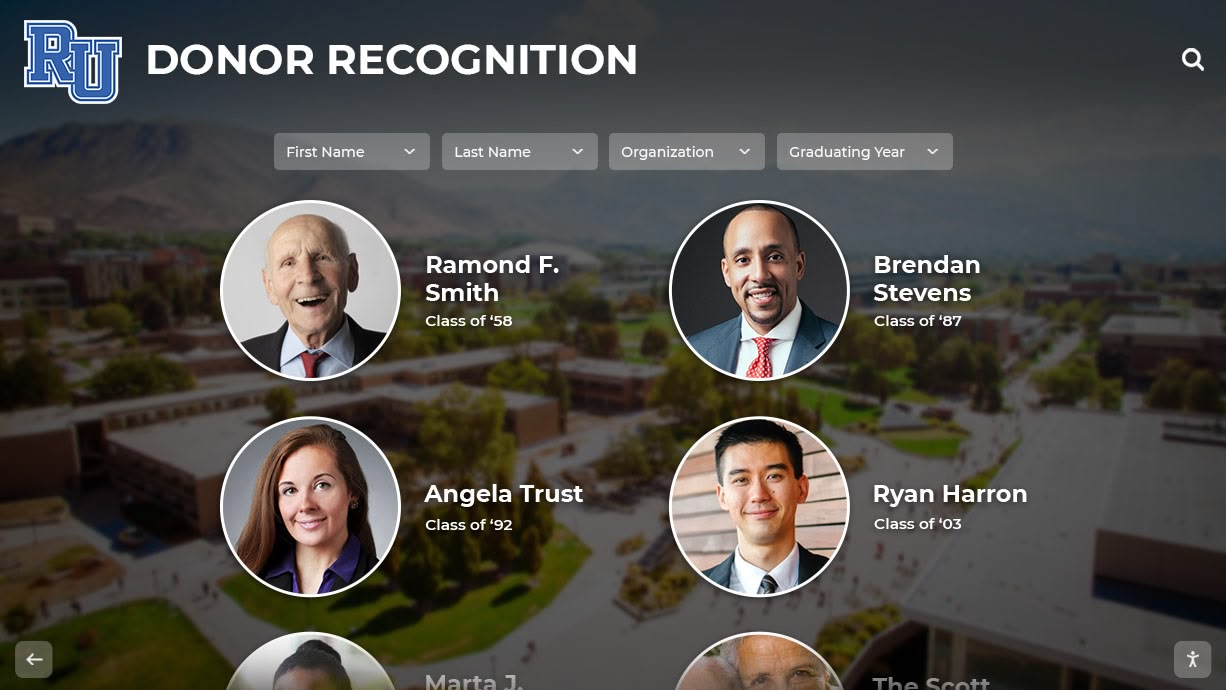
Professional portraits showcase diverse alumni achievements across multiple fields
Educators, Professors, and Academic Leaders
Education represents one of the most impactful career paths, with individual educators influencing thousands of students over multi-decade careers. Recognizing alumni who became teachers, professors, or educational administrators honors those who continue the educational mission.
Education Achievement Types:
- Teachers: Graduates teaching at elementary, middle, or high schools, particularly award-winning or long-serving educators
- Professors: Alumni on university faculties, especially those with tenure, endowed chairs, or distinguished teaching awards
- School Administrators: Principals, superintendents, and district leaders
- College Administrators: University presidents, provosts, deans, and senior academic officers
- Educational Entrepreneurs: Founders of schools, educational technology companies, or learning programs
- Coaches: Athletic coaches at any level who demonstrate teaching excellence and student impact
Teacher and professor alumni often demonstrate willingness to engage with current students through career discussions, mentorship, and advice about educational paths—making them particularly valuable for schools building mentorship programs.
Public Service, Military, and Government Leaders
Alumni who serve in elected office, military leadership, or public service demonstrate commitment to community and country worthy of recognition and student awareness.
Public Service Recognition:
- Elected Officials: Graduates serving in city councils, state legislatures, Congress, or governorships
- Judges: Alumni on municipal, state, or federal benches
- Military Officers: Graduates achieving officer ranks or distinguished military careers
- Military Service: Veterans with significant service records, particularly combat veterans or those with distinguished decorations
- Public Administrators: Graduates in agency leadership, public policy positions, or government management
- Diplomats: Alumni in foreign service, ambassadorial positions, or international relations
- Law Enforcement: Police chiefs, federal agents, and law enforcement leaders
Military and public service recognition demonstrates institutional values around service, sacrifice, and civic engagement while providing examples for students interested in serving their communities and country.
Arts, Entertainment, and Creative Professionals
Creative achievement in arts, entertainment, literature, and media represents another important category of distinguished alumni success deserving recognition and celebration.
Creative Achievement Categories:
- Performing Artists: Musicians, actors, dancers, and entertainers achieving professional success
- Visual Artists: Painters, sculptors, photographers, and visual artists with exhibition records or commercial success
- Writers and Authors: Alumni with published books, successful blogs, or significant writing careers
- Journalists: Graduates in print, broadcast, or digital journalism at respected outlets
- Film and Television: Producers, directors, cinematographers, and entertainment industry professionals
- Design Professionals: Graphic designers, architects, fashion designers, and creative directors
- Arts Administrators: Museum directors, gallery owners, and arts organization leaders
Creative alumni often bring unique perspectives and experiences that resonate with artistically inclined students while demonstrating that creative careers represent viable, meaningful professional paths.
Researchers, Scientists, and Academic Achievers
Scientific research and academic achievement represent forms of distinguished success that advance human knowledge while demonstrating intellectual excellence and persistence.
Academic Achievement Recognition:
- Research Scientists: Alumni conducting research at universities, national laboratories, or corporate research centers
- Medical Researchers: Graduates advancing medical knowledge through clinical or laboratory research
- Academic Authors: Alumni with significant scholarly publications, textbooks, or research contributions
- Patent Holders: Graduates inventing new technologies, products, or processes
- Academic Award Winners: Alumni receiving prestigious research awards, fellowships, or academic honors
- Think Tank Scholars: Graduates at policy research institutions or academic policy centers
For schools with strong academic traditions, highlighting research and scholarly achievement reinforces institutional commitment to intellectual excellence while inspiring academically talented students.
Implementation: Creating Recognition Systems That Engage
Research and database development create foundation, but implementation brings distinguished alumni networks to life through recognition systems that engage current students, honor graduates, and maintain ongoing connections.
Digital Recognition Displays and Interactive Directories
Modern technology enables schools to showcase distinguished alumni far more effectively than traditional static plaques or printed materials. Interactive digital displays create engaging experiences that students actually use while providing flexible, updatable platforms that grow with your program.
Solutions like those from Rocket Alumni Solutions provide purpose-built platforms for alumni recognition, combining touchscreen displays with online directories accessible from anywhere.
Digital Display Advantages:
- Unlimited Capacity: Showcase hundreds or thousands of alumni without physical space constraints
- Rich Multimedia: Include photos, videos, career timelines, and personal messages impossible with plaques
- Searchable Interface: Students search by career field, graduation year, achievement type, or name
- Easy Updates: Add new inductees or update existing profiles instantly without physical reinstallation
- Cost-Effective: Lower per-alumni cost compared to individual plaques for large recognition programs
- Dual Purpose: Same content powers physical displays and online directories for remote access
Placing interactive displays in high-traffic areas—main lobbies, cafeterias, athletic facilities, library entrances—ensures maximum student exposure to alumni success stories while creating gathering points where students explore career possibilities together.
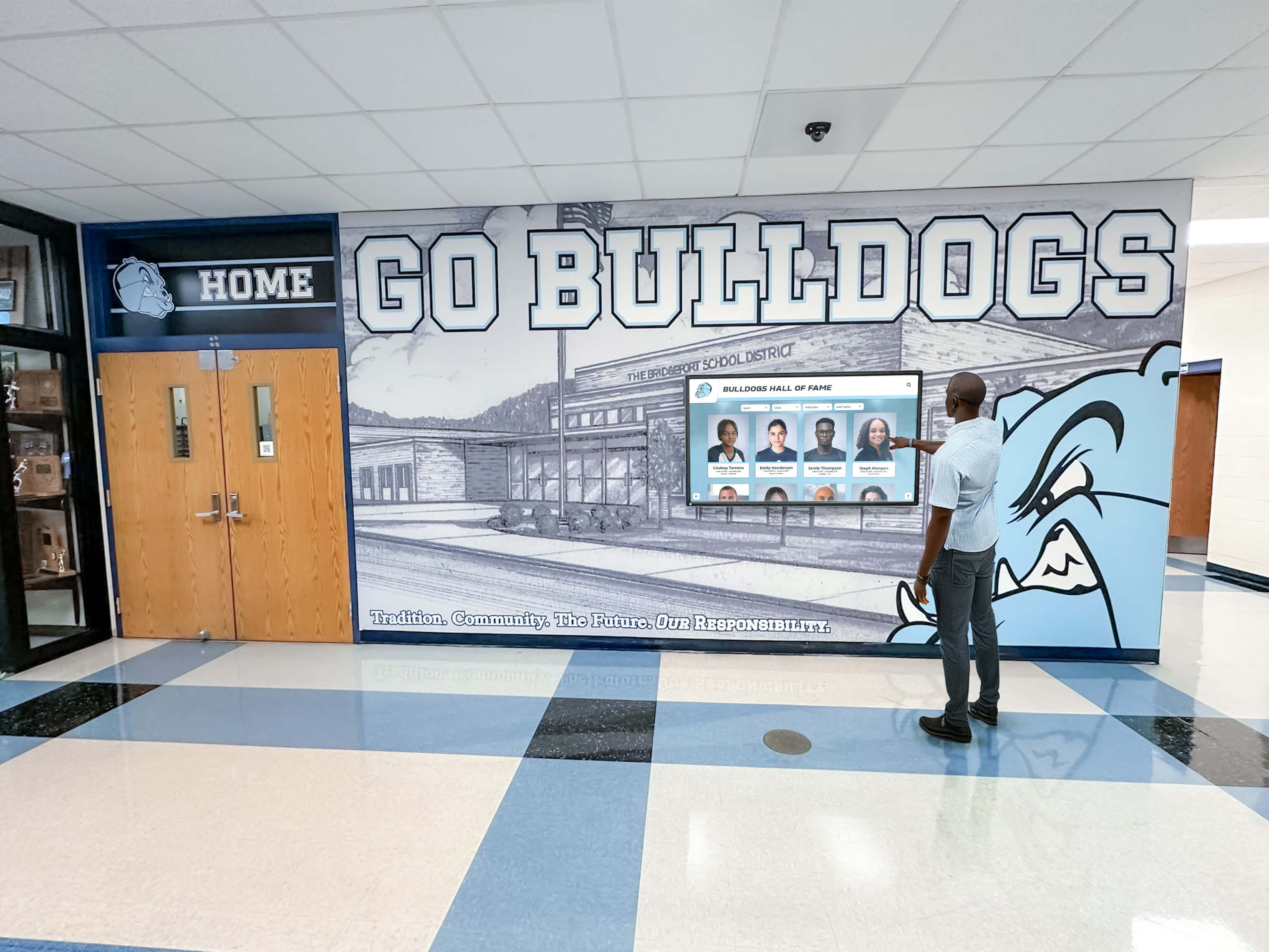
Interactive touchscreen displays engage students with searchable alumni databases
Traditional Recognition Approaches
While digital systems offer tremendous advantages, traditional recognition methods remain valuable for schools without technology budgets or as supplements to digital displays.
Traditional Recognition Options:
- Physical Halls of Fame: Dedicated spaces with plaques, photos, and biographical information about distinguished alumni
- Wall Displays: Corridor or lobby installations featuring alumni photos and achievements
- Trophy Cases: Repurposed or expanded trophy cases incorporating alumni recognition alongside athletic achievements
- Printed Directories: Periodic publication of distinguished alumni directories distributed to community
- Yearbook Sections: Annual yearbook features highlighting recent alumni accomplishments
- Newsletter Spotlights: Regular alumni features in school newsletters or magazines
The key limitation of traditional approaches involves update difficulty—adding new inductees or updating accomplishments requires physical modification rather than simple digital updates. This often leads to recognition systems becoming outdated as maintenance becomes burdensome.
Annual Induction Programs and Recognition Events
Creating regular rhythms for identifying, announcing, and celebrating new distinguished alumni inductees generates ongoing engagement opportunities while building anticipation and prestige around recognition.
Annual Program Components:
Nomination Process: Establish systems for students, staff, parents, and community members to nominate distinguished alumni for recognition
Selection Criteria: Define clear, transparent criteria ensuring consistent, fair selection across diverse achievement types
Announcement Events: Host special programs announcing new inductees, ideally with honoree attendance when feasible
Induction Ceremonies: Create memorable events celebrating new inductees, often during homecoming weekends or school anniversaries
Student Involvement: Include students in nomination review, program planning, or ceremony participation to build ownership and engagement
Community Invitations: Open ceremonies to families, community members, and local media to amplify impact and recognition
Annual recognition rhythms create regular touchpoints maintaining alumni connections while generating recurring media coverage and community engagement that benefits schools beyond individual honorees.
Online Directories and Web Presence
Physical recognition serves students on campus, but online directories extend reach to alumni, prospective families, and the broader community while providing searchable, accessible platforms for discovering graduate accomplishments.
Online Directory Features:
- Public Profiles: Detailed alumni pages with biographies, photos, achievements, and career information
- Search Functionality: Filter by career field, graduation decade, achievement type, or location
- Direct Contact: Enable students to request mentorship or informational interviews (with alumni permission)
- Social Sharing: Allow alumni to share their profiles on LinkedIn, Facebook, or other platforms
- Responsive Design: Mobile-friendly interfaces accessible from phones and tablets
- Alumni Updates: Self-service portals where alumni can update achievements and career milestones
Many schools discover that online directories generate unexpected benefits—prospective families researching schools explore alumni outcomes, college admissions representatives see graduate achievement evidence, and local media discover story opportunities about notable alumni.
Understanding how digital alumni engagement platforms work together helps schools create comprehensive recognition ecosystems rather than isolated initiatives.
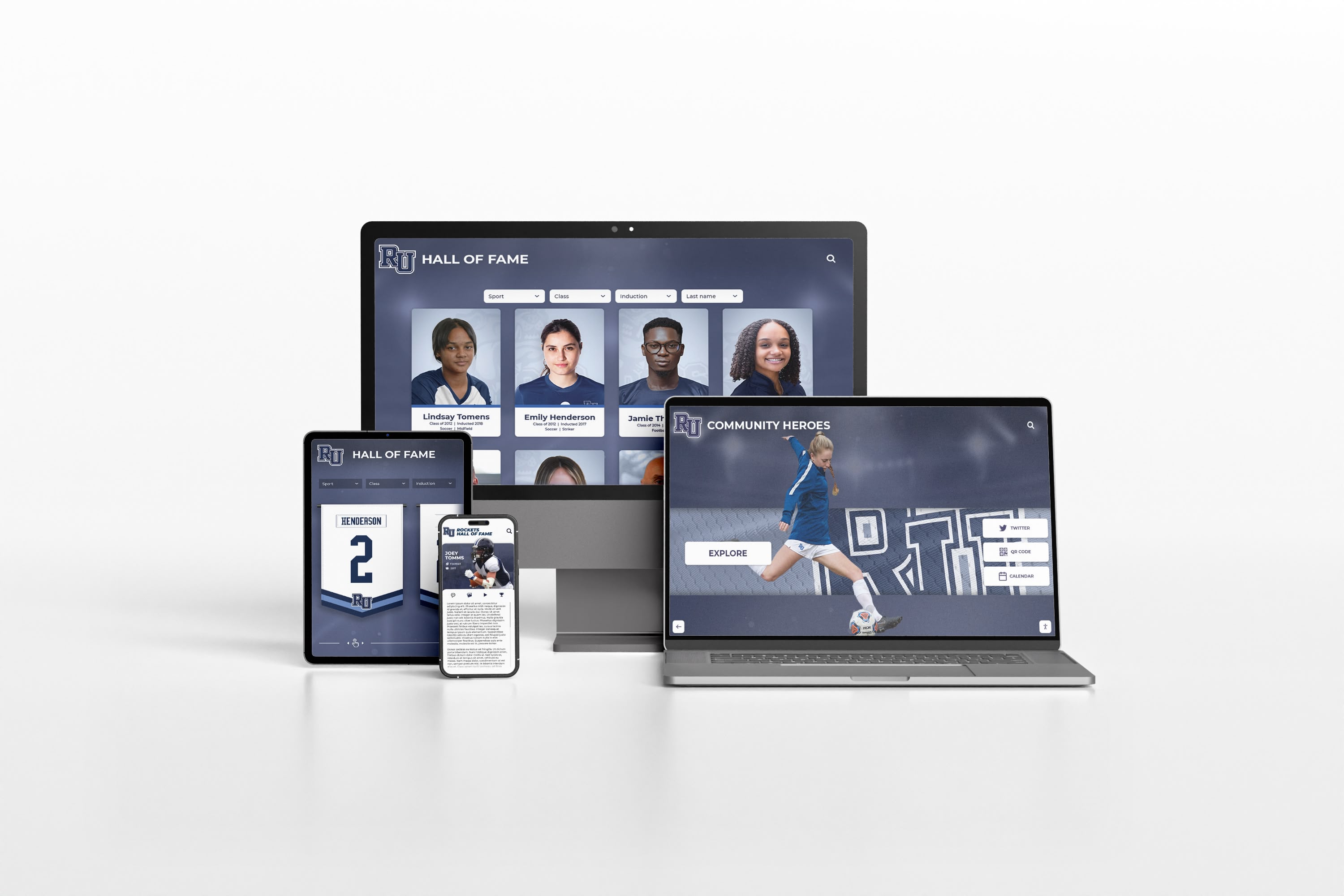
Online alumni directories provide accessible platforms across all devices
Maintaining Engagement: Keeping Alumni Connected
Creating distinguished alumni networks represents the beginning, not the endpoint. Long-term value requires ongoing engagement maintaining connections between schools and accomplished graduates.
Regular Communication and Updates
Systematic communication keeps alumni informed about school happenings while maintaining relationships that support mentorship, giving, and involvement.
Communication Strategies:
- Alumni Newsletters: Quarterly or annual publications featuring school news, alumni updates, and upcoming events
- Email Updates: Regular messages highlighting new inductees, achievement milestones, or involvement opportunities
- Social Media Presence: Dedicated alumni pages on Facebook, LinkedIn, or Instagram sharing accomplishments and connecting graduates
- Personal Outreach: Direct communication with distinguished alumni for specific events, initiatives, or recognition opportunities
- Anniversary Recognition: Contact alumni on milestone graduation anniversaries (10th, 25th, 50th) with updates and reconnection invitations
The Council for Advancement and Support of Education emphasizes that consistent, value-focused communication proves more effective than occasional requests—alumni respond better to schools that maintain relationships rather than those contacting only when seeking donations or favors.
Facilitating Mentorship and Student Connections
Creating structured pathways for students to connect with distinguished alumni for career guidance, informational interviews, or mentorship generates mutual value while strengthening alumni-school bonds.
Mentorship Program Components:
Alumni Profiles: Detailed information about career paths, expertise areas, and mentorship willingness
Student Matching: Help students identify alumni relevant to their career interests or questions
Connection Protocols: Clear processes for students to request contact, ensuring alumni experience appropriate, respectful outreach
Mentorship Guidelines: Structure for informational interviews, ongoing mentorship relationships, or job shadowing experiences
Follow-Up Systems: Ensure students send thank-you messages and updates, maintaining positive alumni experiences
Success Stories: Share examples of beneficial mentorship connections, encouraging additional alumni participation
Research from Big Brothers Big Sisters and other mentorship programs demonstrates that even brief mentorship interactions improve student outcomes—making alumni mentorship among the highest-value engagement activities schools can facilitate.
Annual Events and Networking Opportunities
In-person gatherings create relationship depth difficult to achieve through digital communication alone while providing natural opportunities for alumni to reconnect with schools and classmates.
Event Opportunities:
- Homecoming Recognition: Honor distinguished alumni during homecoming weekends with high attendance and community participation
- Career Panels: Invite multiple distinguished alumni from similar fields for panel discussions with students
- Networking Receptions: Host events where students meet accomplished alumni in informal settings
- Sports Events: Recognize athletic alumni at games, creating visibility while celebrating athletic tradition
- Milestone Reunions: Leverage reunion gatherings to honor distinguished alumni from specific graduation cohorts
- Groundbreaking/Dedications: Invite notable alumni to participate in facility openings or capital project celebrations
Events require planning and resources but generate returns through strengthened relationships, media coverage, fundraising opportunities, and student inspiration that justify investment.
Supporting Alumni Career Development and Networking
While distinguished alumni networks focus on honoring accomplished graduates, many alumni value opportunities for continued professional development and peer networking—creating reciprocal value that strengthens engagement.
Alumni Value Propositions:
- Professional Networking: Connect alumni in similar fields or industries for business development and career opportunities
- Regional Connections: Facilitate alumni meetups in cities with graduate concentrations
- Industry Groups: Create affinity groups around career fields enabling peer networking and collaboration
- Continuing Education: Offer professional development programs, workshops, or speaker series valuable for career advancement
- Business Promotion: Feature alumni businesses in school communications, creating visibility and referral opportunities
- Community Service: Organize volunteer opportunities where alumni contribute collectively to community causes
The most successful alumni networks recognize that engagement represents mutual relationships rather than one-way asks—schools providing value to alumni receive stronger support for institutional initiatives in return.
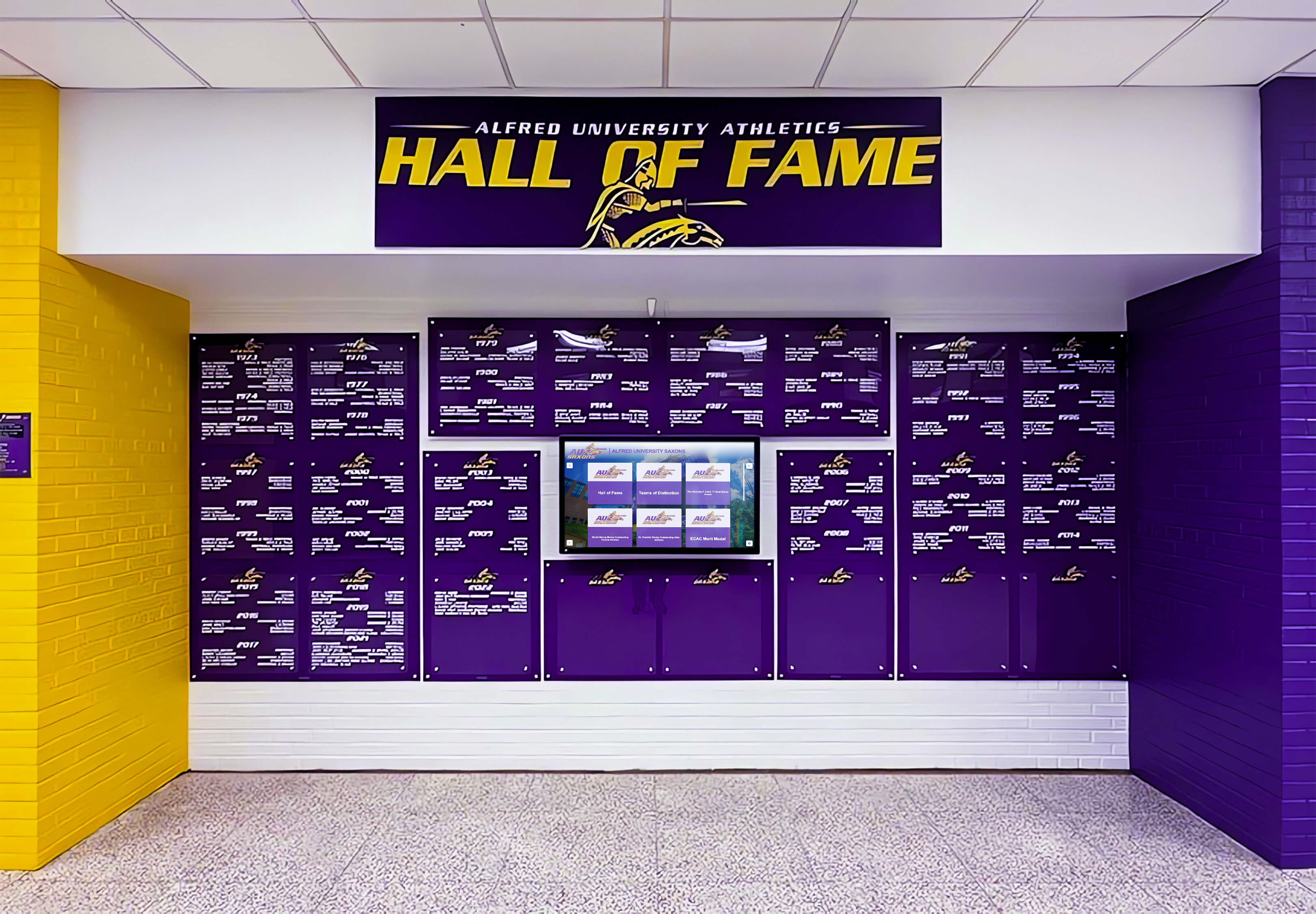
Branded recognition displays create institutional pride while honoring graduate achievements
Measuring Success and Demonstrating Value
Distinguished alumni programs require ongoing staff time, financial resources, and administrative attention. Measuring outcomes and demonstrating value ensures continued institutional support while identifying improvement opportunities.
Key Metrics to Track
Quantitative Measures:
- Database Growth: Number of distinguished alumni identified and profiled over time
- Student Engagement: Display interactions, directory searches, mentorship requests, career panel attendance
- Alumni Participation: Response rates to outreach, event attendance, mentorship volunteering
- Giving Metrics: Donation participation rates and average gifts from engaged versus unengaged alumni
- Media Coverage: Local news mentions, social media reach, community visibility
- Website Traffic: Online directory visits, page views per session, return visitor rates
Qualitative Indicators:
- Student Testimonials: Stories about how alumni connections influenced career decisions or college plans
- Alumni Feedback: Comments from recognized alumni about their experience and appreciation
- Parent Perceptions: Family feedback about distinguished alumni programs as enrollment decision factors
- Community Sentiment: Local perception of school quality influenced by visible graduate success
Regular measurement enables data-driven optimization—understanding which features, events, or communication approaches generate strongest engagement guides resource allocation toward highest-impact activities.
Demonstrating ROI to School Leadership
School administrators and boards require evidence that distinguished alumni programs deliver value justifying continued investment. Comprehensive reporting makes the case persuasively.
ROI Documentation:
- Student Impact: Document mentorship connections, informational interviews, internships, and job opportunities created through alumni networks
- Fundraising Results: Track giving increases among engaged alumni versus control groups
- Recruitment Evidence: Survey prospective families about whether distinguished alumni influenced enrollment decisions
- Media Value: Calculate publicity value of earned media coverage featuring alumni accomplishments
- Community Perception: Share survey data showing enhanced school reputation connected to alumni recognition
- Comparative Analysis: Benchmark against peer schools with and without distinguished alumni programs
For schools implementing comprehensive digital recognition systems, documenting usage metrics demonstrates tangible engagement rather than relying solely on subjective impressions of program value.
Common Challenges and Solutions
Schools building distinguished alumni networks encounter predictable obstacles. Understanding common challenges and proven solutions accelerates implementation while avoiding frustrating pitfalls.
Challenge: Limited Staff Time and Resources
High schools typically lack dedicated alumni relations staff, making comprehensive alumni programs feel overwhelming when added to existing responsibilities.
Solutions:
- Phased Implementation: Start small with focused recognition of one category (athletes, for example) then expand systematically
- Volunteer Committees: Recruit parent volunteers, retired teachers, or community members to assist with research and planning
- Student Involvement: Engage journalism, marketing, or technology classes in alumni research and profile development as educational projects
- Technology Leverage: Use digital platforms requiring minimal ongoing maintenance rather than labor-intensive traditional approaches
- Scheduled Rhythms: Establish regular quarterly or annual update cycles rather than attempting continuous management
Challenge: Locating Lost Alumni
Schools often lack current contact information for graduates from more than a few years ago, making research and engagement difficult.
Solutions:
- Social Media Research: LinkedIn, Facebook, and Instagram enable finding alumni even when contact information is outdated
- Reunion Networks: Engaged classmates from active reunion committees often maintain contact with cohort members
- Community Referrals: Current staff, parents, and local residents frequently know alumni personally or professionally
- Alumni Helping Alumni: Each located alumnus can often connect you with additional classmates
- Professional Services: Consider commercial alumni data services providing contact information from consumer databases
- Public Records: Marriage records, property records, and professional licensing databases help locate graduates
Challenge: Ensuring Inclusive Recognition
Programs focused exclusively on wealthy business leaders or famous athletes miss opportunities to recognize diverse forms of achievement while potentially alienating students interested in service, education, or creative fields.
Solutions:
- Explicit Criteria: Define distinguished achievement to explicitly include service, education, community impact, and creative accomplishment
- Category Balance: Ensure each induction class includes diverse achievement types rather than concentrating on single categories
- Nomination Review: Diverse selection committees catch blind spots and advocate for overlooked achievement types
- Featured Spotlights: Regularly highlight various alumni types ensuring all students see relevant examples
- Community Input: Solicit nominations from students, parents, and staff to surface accomplished alumni outside traditional networks
Challenge: Managing Privacy and Permission
Some accomplished alumni prefer low profiles, avoid publicity, or want to protect privacy—requiring schools to balance recognition desires with individual preferences.
Solutions:
- Permission Protocols: Always request explicit permission before prominently featuring alumni, explaining exactly how their information will be used
- Opt-Out Options: Allow alumni to decline recognition or request limited information sharing
- Tiered Visibility: Offer options for public, alumni-only, or private listing with varying information disclosure
- Content Approval: Let alumni review and approve any biographical content before publication
- Respect Boundaries: Honor declining alumni gracefully without pressure or implied judgment
Understanding privacy considerations in alumni databases helps schools navigate these sensitive situations appropriately.
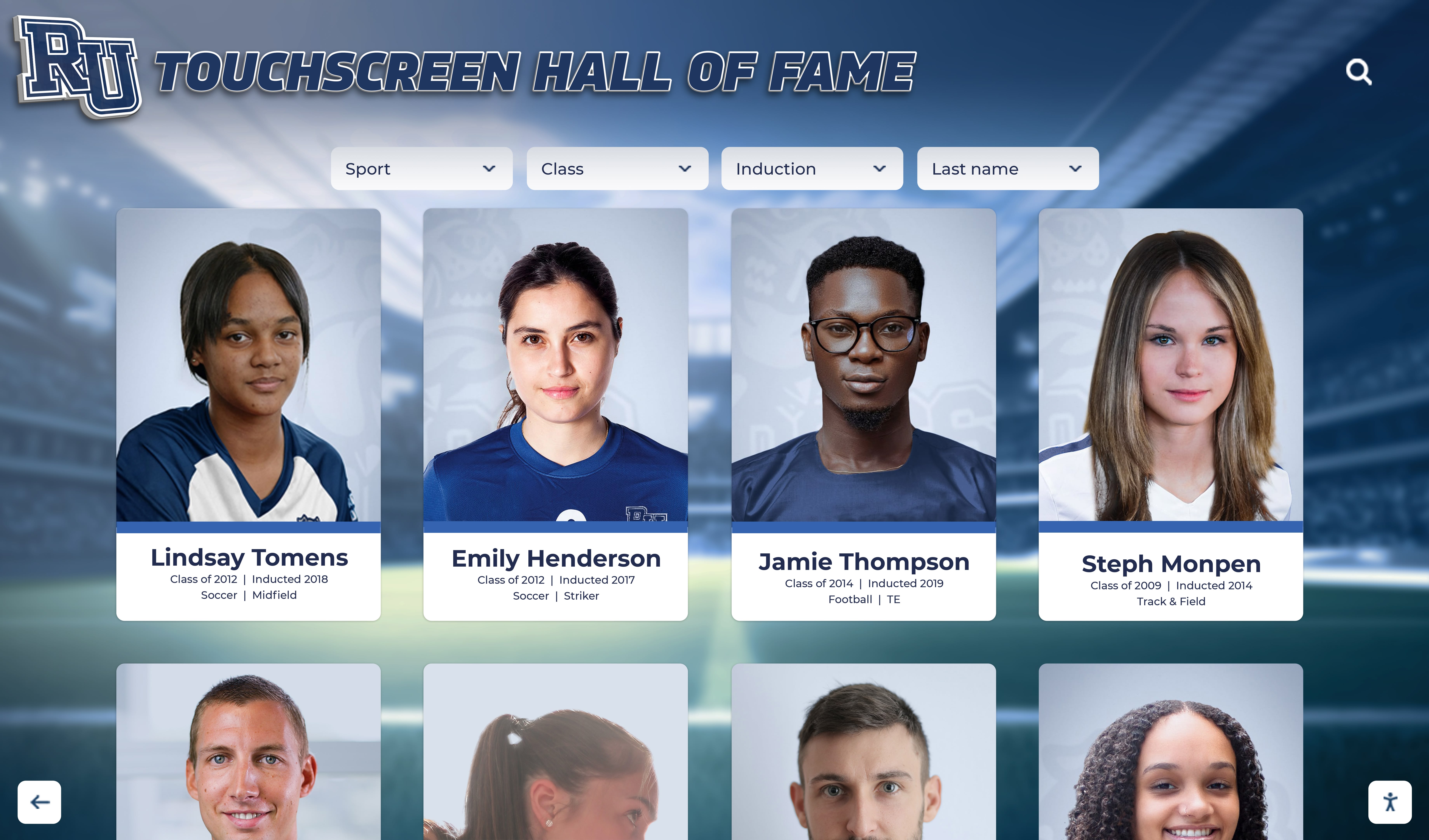
Digital displays accommodate privacy preferences while celebrating willing alumni
Technology Solutions: Choosing the Right Platform
Schools implementing distinguished alumni networks face decisions about technology platforms that will support recognition, database management, and ongoing engagement.
Evaluating Digital Recognition Systems
When comparing platforms, prioritize features directly supporting your program objectives rather than getting distracted by peripheral capabilities you won’t use.
Essential Features:
- User-Friendly Content Management: Non-technical staff must be able to add inductees, update profiles, and manage content without IT assistance
- Flexible Profile Structure: Accommodate diverse achievement types and information categories rather than rigid templates
- Multimedia Support: Handle photos, videos, documents, and biographical text in integrated displays
- Search and Filtering: Enable students to discover alumni by career field, location, graduation year, or achievement type
- Mobile Responsiveness: Function excellently on smartphones and tablets students actually use
- Online and Physical Integration: Same content powers touchscreen displays and web-based directories
- Analytics and Reporting: Track usage, engagement patterns, and platform effectiveness
Secondary Considerations:
- Integration Capabilities: Connect with existing databases, websites, or communication platforms
- Customization Options: Match school branding, colors, and design preferences
- Support Quality: Responsive vendor assistance for setup, troubleshooting, and questions
- Scalability: Handle growing databases as programs expand over time
- Security: Protect sensitive alumni information appropriately
Rocket Alumni Solutions specializes in education-focused platforms designed specifically for schools rather than generic databases requiring extensive customization. Purpose-built solutions typically provide faster implementation and better user experiences than adapted corporate systems.
Implementation Timeline and Process
Realistic planning sets appropriate expectations while ensuring thorough implementation that creates sustainable programs.
Typical Timeline:
Months 1-2: Planning and Research
- Define program objectives and recognition criteria
- Identify initial inductee cohort through research
- Select technology platform and finalize budget
- Establish policies around privacy, selection, and communications
Months 3-4: Content Development
- Contact identified alumni requesting permission and information
- Gather photos, biographical information, and achievement details
- Write profiles and prepare multimedia content
- Review content with alumni for approval
Months 5-6: Platform Setup and Launch
- Configure digital displays or traditional installations
- Load initial content and test functionality
- Train administrators on content management
- Plan launch event and communications
Month 6+: Ongoing Operations
- Regular content updates with new inductees and achievement milestones
- Systematic outreach to additional distinguished alumni
- Programming around mentorship, events, and engagement
- Assessment and optimization based on usage data
Most schools find that initial program development requires significant upfront effort but that ongoing operations become manageable with established processes and technology support.
Best Practices from Successful Programs
Schools achieving exceptional results with distinguished alumni networks share common approaches worth emulating.
Start with Champions and Expand Gradually
Begin recognition with alumni likely to respond positively—recent graduates maintaining school connections, local alumni active in the community, or those who’ve previously expressed willingness to be involved. These initial successes build momentum, generate word-of-mouth promotion, and create examples attracting additional participation.
Celebrate Diverse Achievement Types Explicitly
Make deliberate efforts to recognize varied accomplishment forms rather than inadvertently concentrating on business success or athletic achievement. Students benefit most from seeing multiple pathways to meaningful careers and lives.
Leverage Homecoming and Reunion Events
Annual school traditions provide natural opportunities for alumni recognition without creating separate events requiring new logistics and attendance building. Recognizing distinguished alumni during homecoming creates visibility while honoring graduates in celebratory contexts.
Involve Current Students in Programs
Student participation in nomination processes, content creation, event planning, or mentorship coordination builds ownership while developing valuable skills. Students also bring perspectives that adults might miss about what makes alumni recognition engaging and relevant.
Maintain Consistent Communication Rhythms
Regular touchpoints—quarterly newsletters, annual update requests, periodic event invitations—maintain relationships more effectively than sporadic contact. Alumni respond better to schools demonstrating consistent interest rather than only reaching out when seeking donations or favors.
Document and Share Success Stories
Collect and promote specific examples of program impact—students securing internships through alumni connections, graduates crediting recognition for continued school involvement, or mentorship relationships leading to meaningful career guidance. Concrete stories prove value more persuasively than abstract claims.

Integrated displays combine traditional aesthetic with modern interactive technology
Conclusion: Building Lasting Alumni Connections
Distinguished alumni networks and databases represent far more than simple recognition programs—they create infrastructure for ongoing relationships that benefit schools, graduates, and current students for decades. When implemented thoughtfully with appropriate technology, clear processes, and sustained commitment, these programs generate measurable returns across multiple institutional priorities.
The most successful initiatives recognize that alumni engagement represents long-term relationship building rather than transactional interactions. Schools that provide genuine value to accomplished graduates—celebrating achievements, facilitating meaningful connections, creating community among cohort members—receive enthusiastic support for institutional initiatives in return.
Current students represent the ultimate beneficiaries, gaining exposure to tangible examples of achievable success, access to mentorship from accomplished professionals, and inspiration for their own educational and career aspirations. The teacher who sees a former principal featured in recognition displays, the athlete who discovers a professional player graduated from their program, or the business-minded student who connects with an entrepreneurial alumnus all benefit from systematic efforts to maintain distinguished alumni networks.
For schools ready to honor accomplished graduates while building engagement infrastructure that strengthens institutions, modern solutions make comprehensive programs accessible even for schools with limited resources. Digital platforms eliminate the physical space constraints and cost-per-inductee limitations of traditional approaches while providing flexibility, searchability, and multimedia richness impossible with static displays.
Ready to Build Your Distinguished Alumni Network?
Discover how digital recognition platforms can help your school identify, celebrate, and maintain connections with accomplished graduates across all achievement types. Rocket Alumni Solutions provides comprehensive systems designed specifically for educational institutions seeking to honor distinguished alumni while building lasting engagement.
Explore Alumni Recognition SolutionsWhether beginning with focused recognition of one achievement category or implementing comprehensive programs showcasing diverse graduate success, the investment in distinguished alumni networks pays dividends through enhanced student motivation, strengthened community pride, valuable mentorship connections, and sustained alumni engagement that supports schools throughout their evolution and growth.
The graduates who walked your hallways and sat in your classrooms have gone on to accomplish remarkable things—professional athletes competing at elite levels, business leaders building successful companies, medical professionals saving lives, educators shaping future generations, and community servants making lasting impact. By systematically recognizing these accomplishments, schools honor distinguished alumni while inspiring current students with tangible examples of what they too might achieve.































